Wayne C. Allen's Blog, page 4
December 8, 2024
As Within, so Without

As Within, so Without is a message of freedom. We have created the reality in front of us, and at any time can shift things in another direction. All that’s required is focussed action.

Looking for more on this topic?
Check out my book,
Half Asleep in the Buddha Hall.
Wayne’s “Eastern” book takes you by the hand and helps you to find peace of mind. Half Asleep in the Buddha Hall is a Zen-based guide to living life fully and deeply.
Unresolved “mother” issues are common, but remember, so are the following, and more: Unresolved
father issues,issues with dependent people,issues with demanding people,issues of sexual attraction,issues regarding touch and intimacy,communication issues.And on and on.
The “cure” to unresolved issues is to let go of what is not working, and experiment with new approaches.We resolve the issue directly in front of us. Not for all time (impossible!) but simply for this time.
“Back to “mommy issues.”A reader wrote:
“I’ve been trying for years to break the cycle by changing my behaviour toward my mother. How do I get my mother to love me? I’ve changed everything she asked me to and she still doesn’t love me. She just demands more change.”
 Such game playing is not limited to “moms.”
Such game playing is not limited to “moms.”You can’t win someone’s love (or even their regard) by endlessly trying to do what they demand of you.
In the above scenario, the “mom” is heavily invested in proving her daughter either wrong or dysfunctional, or both.
If the daughter changes her behaviour to match the (latest) demand, “mom” will simply create another demand.
Some relationships are never going to work out. Some can be modified. But you will never get anywhere in life or relating if you endlessly attempt to change yourself according to the demands of others.
Here’s the game:
They say, “If you love me you’ll do (whatever.)” You do whatever. What you have set up is, “Tell me what to do, wrap it in a threat to withhold love, and I’ll do whatever you tell me.” Likely, then, the next thing you’ll hear is, “If you really love me you’ll do this other thing (or behave in a certain way) and I’ll love you in return.”And on and on.
In relating, you get what people choose to give you. Playing games changes nothing.You have total choice regarding your response to what they give you, and total choice as regards who you choose to be.
This blog promotes embracing a life approach centered in your self. You become real through ceaseless reflection on, observation of, and dialog with yourself. From this reflection, you enact behaviours designed to match your inner reality.
It’s also about feeling your feelings, without judging them to be “good or bad” feelings.
Your self-dialog and your feelings are then shared with others through intimate conversation. The dialog is never about manipulating others into changing, nor is it about changing yourself into what others want you to be.
Look around you, at your life. You, and only you, made this.You picked, you chose, and here you are, living this life. Further, your external reality is a precise reflection of who you are, on the inside. (The Buddhist version of this is: “All that you are is a result of what you have thought.”) As within, so without.
If you don’t like either your internal or external life (or both,) you start shifting what you can shift (hint: you can’t shift externals!) — your own behaviours, perceptions, ways of understanding.
Holding on to something (a failed idea, a dream of winning someone’s love, a restricted self view) causes you pain, and soon it becomes a physical block, a stuck pattern, and you are destined to feel pain and repeat the experience.
Becoming an adult is about finding yourself in your own context, and from there choosing how to relate both with others and with yourself.
Being who you are is never about obedience, doing it the way someone else wants you to. If people insist that you change to make them happy, resist, gently, and be yourself. If they can’t handle it, you’ll have to walk away.
Or, you’ll spend the rest of your life trying to be who someone else wants you to be.
Realizing this, and becoming self-responsible, takes wisdom. And wisdom is practice. Therefore, the wise person practices wisdom.Wisdom is different from intelligence. I know many brilliant people whose personal lives are in the dumper, simply because they have not cultivated wisdom. The wise person believes and acts as if they have an endless list of available choices for the situations they confront.
It would never occur to a wise person to repeat a behaviour that didn’t get the results they wanted.
It’s like being caught in a building. One guy goes to the window, and searches for the crank. The wise person, seeing that the window is sealed, tries the door. The silly person stands at the window, saying over and over, “I’m sure if I look harder I’ll find the crank.”
Oftentimes people will complain that change takes a long time. They’ll try something, and get slightly better results and think, “At this rate I’ll be at this for the rest of my life.” They make a subconscious decision that, because change takes time, maybe they’ll just go back to doing things the old way.
The results of that way are not what they want — they may even be making themselves sick in the process, as their bodies break down from lousy choices, but the path to another way seems altogether too long, too hard.
So, they stop, and simply feel sorry for themselves. And get sicker. And eventually die. Seems sorta sad, eh?
I believe that we are on a path of incremental change. Who I am at the core of me is not changeable. What can change is how I choose to act, despite who I am at my core.
The beginning of change is often a small step into a new direction. Recognizing and celebrating this is far better than staying stuck in the familiar, non-functional known.
Facebook TwitterDecember 1, 2024
Untwisting
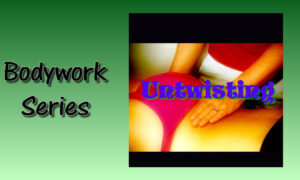
Untwisting our bodies first of all starts with untwisting our minds long enough to hear what our bodies have to say.

PDF downloadable book and online videos. More info here.
Untwisting ourselves is not difficult, but it does take effort. We have to use techniques to explore the “root causes,” and then use various Bodywork techniques to let go.
A couple of articles back I wrote about about being “twisted.”The way to body works as regards holding pain goes back forever. For example, this:
Our compensations become our reality…a massage therapist was holding the sacrum of a client, who then started to “see” what was going on in her body. She’d been in an auto accident, and was compensating. Her body was “twisted,” but thing thing is, after compensating for whatever, you stop noticing the compensation. Twisted becomes normal.
Back in the 1920s-30s, a psychotherapist, a 20th century student of Freud, Wilhelm Reich, identified what he called body armor / character armor. He described the armoring as physical blockages to the free flow of energy.
He worked with his clients by adding in bodywork and breathwork, as he realized that talk therapy alone wasn’t cutting it as far as healing went.
He realized that trauma of any sort that was not resolved (through the release of the blocked energy) ended up “stuck” in the bodyThis is armoring — the tightening down of muscles so that the trauma is “held in place,” as opposed to expressed and released. The longer it’s held, the tighter and more blocked the person becomes.
Reich equated physical and psychological pain to restricted energy, which of course also sounds like Chinese medicine. He dubbed the energy “orgone energy.”
Most blocks are not caused by physical injuries.They’re caused by unresolved trauma. That trauma can relate to upbringing, sexual or physical issues / events, and decidedly by how we view ourselves.
This week, I want to talk about how to discover what’s going on for you,as you explore what might be getting “caught” in your body.A decade ago, I started leaning to the right at my pelvis, this caused by a wonky SI joint. I did Bodywork and physio for it, and am almost straight again. After this happened I started to notice how many others had similarly twisted lower backs.
I was amazed, on Playa Samara, to see lots of teenagers and 20-somethings with the same out-of-alignment lower backs.

I created a movie of the woman in the centre. It’s for the Bodywork book I wrote.
The images show:
1) me, tilted right at the pelvis, 2) a woman tilted high left at the shoulders, high right at the pelvis (her rib cage is compressed on the right, and 3) a woman with a level pelvis.Please note! The hips of all three people stay the way you see them as they walk!!!
If you’ve been reading me for long, you know one of my issues is a combo.
The a) part is that I have a burning desire to be “of use.”The b) part, which is contradictory, is that I also think that people don’t like me for me… they like me for what I do. This can quickly become resentment and sadness.Both of these are sacral, 2nd Chakra issues. No coincidence, then, that this area of my body gives me trouble. I hurt, especially if I sit too long.The idea with Bodywork is to go where the pain or resistance or blockage is, and to help the places to release. The principal approach is to apply enough pressure to help the muscles let go, and then to continue until the underlying pain is expressed.
What I’ve learned as a bodywork recipient: I do not need to come to any conclusions about why I do what I do to myself. I already, in fact, have a pretty good story invented about “why.” I just need to straighten out my twists, breathe into them, and then let go of any emotion that comes up.
Most, on the contrary, find excuses for not working things through — that’s how they got “twisted” in the first place. Many know exactly where they’re are caught, and how.
They recognize that releasing might be messy, or noisy, or angry, or emotionally charged, and they step back. The key is to let go of a lifetime of stories. That letting go is going to have something to do with being locked in by our minds — forbidden, in a sense, to feel.
An exercise to begin the processThis exercise is found in my web book / video series on Bodywork.

PDF downloadable book and online videos. More info here.
At workshops, I often read a heart meditation; I decided to write my own heart meditation for this article.
I’ve also recorded it, and you can download the mp3 file here. (right click to save) OR… left click the above link, and it ought to play!
Heart Release MeditationBegin by finding a place to lie down. Adjust yourself so that you feel comfortable, secure, and safe.
Begin to breathe in and out, softly, and gently, being aware of the breath as it moves through your mouth and nose. Feel the breath filling your lungs, fully and deeply.
Now, using your fingers, locate your breastbone.
Slide your fingers outward, toward the place where your ribs meet your breastbone. Move your fingers into the spaces between the ribs, and press inward a bit, feeling for soreness or tenderness.
When you find the spots that seem the most tender, rest your fingers there.
Breathe.
Press the tender spots gently, and then increase the pressure until you are aware of the pain you hold in your chest.
Breathe into the pain.
Allow your mind to float free.
Recall situations in your past where your heart has been hurt.
Perhaps someone abandoned you. Friends, loved ones, may have died. Situations, jobs, careers may have ended or been taken from you.
See what emerges from your mind’s storehouse of memories.
Recognize that you have pushed these memories away. You told yourself that you’d grieved enough, that it was time to move on. Or you promised yourself that someday, eventually, at the right time, you’d come back to revisit the pain of your loss.
And you never did.
Until now.
The mind stores data. And it replays the data as it seems appropriate. Often, our painful, unresolved memories become the things our dreams are made of.
Our waking moments trigger memories we thought were lost in the recesses of the past.
Breathe. Take in a “breath of calm surrender” to all of your memories, good and bad.
Continue to apply pressure to the tender area.
Open yourself to the possibility that you cannot think a feeling.
Your heart is designed to be vastly capable of containing all that you feel, all that you hope, all that you dream.
As you let down the walls you have erected to guard yourself from further hurt, you begin to feel just how big your heart is.
Breathe. Acknowledge that, in the past, your pain caused you to tighten up. Your shoulders rolled forward, as you attempted to protect your heart from further hurt.
You became blocked, rigid, and unloving – of your self – of others.
Far from protecting yourself, your tightness only isolated you from others.
Breathe. Open to the possibility of letting go. Feel the tender spot beneath your fingers and be kind with yourself.
Recognize that all of the avoidance did not diminish your pain. All that it did was push it deep inside. Your mind seized upon it and obsessed over it. Your mind found people to blame for all of your pain, and when no one was convenient, your mind blamed you.
And you blamed you, and tightened more, and hunched your shoulders and rolled them over your heart, and from there, attempted to live.
No more.
Open yourself, right now, to feel the pain beneath your fingers. Let your sadness and loss be real for you. Open the centre of yourself – open your heart and let in all of the hurts and sadness of your life.
Feel them. Let your heart do what it is best at.
Grieve your losses.
Breathe.
Let go of your need to hold on to your pain, to your stories, to your victim stance. Let it all go.
Let your heart absorb your thoughts and remembrances.
Let your heart begin to feel. Everything.
Notice that, as your heart begins to feel, the pain beneath your fingers is diminishing. Your muscles are relaxing. The pain in your tender spot is easing. You feel your heart opening.
Breathe. Recognize that blocking your heart from your pain means you’ve also blocked yourself from giving and receiving love.
Love is meant to be given with abandon, received with abandon. Love is not doled out with an eyedropper, but rather is released as a flood.
Open yourself to feeling compassion – for yourself and for others.
Breathe compassion out into the Universe and breathe compassion for yourself into every cell of your being.
Notice that the pain at your tender point is almost gone. A remnant remains, not the result of refusing to feel, but rather because, as humans, we all hurt.
All of us are broken at the heart.
Breathe, and have compassion.
Let your hand fall away from your tender spot.
Breathe in the freedom that comes as you open your heart to yourself and to the universe. Notice your relaxing muscles, the ease with which your lungs fill with air, and then release it back.
Breathe. Feel what it means to be human and let yourself hold your heart fully and widely open.
Let your breath return to normal and feel yourself sinking deeply into the ground. Relaxing. Letting go.
Stay there until you are ready to carry on with your day.
Facebook TwitterNovember 24, 2024
Getting out of Bondage
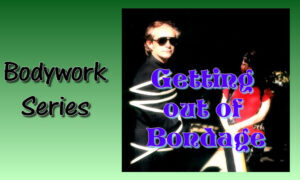
Getting out of Bondage — sometimes, the way out is the way through — you gotta figure out who you are, and go for it — without regard to “normal.”

My first and most popular book,
This Endless Moment.
Learn to live a full and satisfying life.
I was making the point that while pain might be a natural occurrence — an “I hit my thumb with a hammer” kind of thing — it’s also a drug of sorts. Many people “get off” on feeling “bad,” and twist their reality to have more of it.
Relationships are a prime targetPeople get into relationships for lots of reasons, and for pain addicts, it’s to “feel hard done by.” They push and push, and when the push-back comes, they get to play victim. They set up un-winnable games, and have a great sense of satisfaction that once again they are in pain.
Many of my past clients did exactly this — they entered relationships that “made them” feel awful — punished.People in bad relationships are sub-consciously meeting a deep need to feel pain. Engaging in screaming matches is the same thing as wanting to feel physical pain. Manipulation is a game to never quite get what you want.
“Bad relating” is just a matter of degree.
I used the illustration of my mom wanting to be the sickest person in the room. This was not a hobby… this was a deep-wired part of her personality. It drove many of her choices, including her choice to be 70 pounds overweight and to continue to pack in the sugar even after ending up with diabetes.
She found pleasure in her pain. Perhaps, if she had tried, she could have found another way.
Some do it with work or school… they love pain and feeling “oppressed or prejudiced against,” so they set themselves up for conflict / failure so as to feel “normal.”They can tell me their patterns… how they can’t seem to stop doing what they say they don’t want to do… And yet, each and every time, the go right back to setting things up to think they’re hard done by.
Call me silly, but if they have such a burning desire to feel failure, perhaps they could find another thing to strategically fail at.
I’d rather they come up with an alternative, as opposed to repeating what doesn’t work, and then judging themselves for doing it again.In a sense, It “sounds like”: Finding a benign way to feel pain fully, without setting things up so that they simply end up playing the victim. Big price to pay for a little jolt of pain-pleasure.
Now, some therapists might argue that finding a way to experience pain without drama is “wrong, or not normal.” They try to get their clients to stop doing what they’re doing (me too… I hate watching people repeat ineffective behaviours…)
What this sounds like is, “Your addiction to pain-pleasure is wrong.” I disagree. It’s not the need to feel and process pain that is “wrong.” It’s using dumb ways to accomplish it that seems silly.
So for example:
a person who needs to feel pain and who does it through BDSM no longer needs to create crappy relationships — they have their outlet.The person who needs sexual variety, and who sets up honest, open relationships, no longer has to sneak around. The person who want to experiment with something new can just go do it (safely), instead of coming up with tortured logic to justify their behaviour.For example, lots of people make it difficult to admit out loud to being sexually turned on.I wrote the following in my book, This Endless Moment
I once worked with a 21-year-old who, some months earlier, had broken up with a guy for having sex with a female friend of his. She’d gotten back together with him, and was engaged to him.
One evening she went to visit a male friend of hers and ended up having sex with him, on a pool table, no less. The next day she decided she had to dump her boyfriend because she was sure that having pool table sex with her friend meant she must love him and not her boyfriend. (Confused? She’s living this stuff.)
I asked her about the obvious: did she not see that she had just done what she’d dumped her boyfriend for (both had sex with a friend)? She looked confused and said “He did it for sex. I did it because I think I must love him.” I asked her what was wrong with being horny and doing something about it. She blushed, and repeated her mantra: “It’s not about sex, it has to be love.”
Her conflict is what we have been describing—she has a hard time admitting to being sexual and acting out of horniness, no trouble at all equating the wet and warm feelings with “true love.” She is so trapped in this thinking that she ended a 5‑year relationship because she had sex with someone else. Doesn’t that strike you as odd?
Repression simply leads to breakdown or explosion.In Marty Klein’s book, Sexual Intelligence, he makes this same point. He calls out therapists who make themselves uncomfortable over the sexual activities of their clients. He says that often therapists are uncomfortable about sex and their own sexuality, and fall into the trap of declaring what “normal” is.
And then, they try to move their clients toward “normal.”
Except there is no normal.
Or better put, statistical norms exist, but are irrelevant on a case-by-case basis.
A simple example: a certain cancer has a 75% mortality rate. So, if you have that form of cancer, what’s your mortality rate — what’s going to happen to you?
Answer: there’s no way to predict. A statistical norm has nothing to do with an individual case.
Thus, the real thrust of Klein’s book, and of this blog, and of my work, and of my life, is this: you need to discover:
who you are, what you want, be willing to stop judging what isn’t working, while experimenting with alternative behaviours,thus moving in a direction you chooseNot toward a statistical norm of “adult behaviour” (yuck! spare me!) but toward finding and enacting “you.”Different from “the norm,” to me, is a wonderful, wonderful thing.
I see in my mind’s eye what could be. And many times people I know have discovered “amazing powers.”To paint. To create. To build excellent relationships.
The sexual explorers have discovered all kinds of orgasmic delights. Polyamory. BDSM as a tool for letting go. Sexual intimacy projects.
Normal? By whose standard? According to whom?Interesting? Hell, yes.
Others, the majority, stop themselves. They stay in dead relationships, or refuse to deal with the consequences of their behaviour. If they are slightly thwarted, they go running home to mommy.
They dig a hole over a decade, and then expect it to fill itself in, so they can walk our unscathed.
They cling to the past, blame others, (“Men!” “Women!”) or use substances to get through the day.
I despair a bit.But then, I remember the ones who choose to fly, to explore, to ask for what they want, to open themselves to actually being exactly who they are.
They have a slightly shell-shocked look about them — “I can do that? Wow!” Or, “Oh! I thought that was weird and wrong, and now I see it feels good and is so right… for me!”
Thus I mention things that will challenge, stretch and turn you on. The world is sinking slowly in the muck of mediocrity, of rules and regulations… of normal, brittle, and boring.I want to offer another way… and this is it..
Facebook TwitterNovember 17, 2024
Drama and Being Twisted
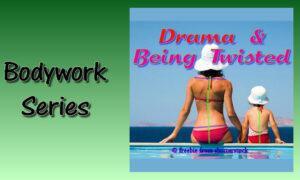
Drama and Being Twisted — we look at letting go of the need to create charge by being dramatic

PDF downloadable book and online videos. More info here.
Lately, I’ve been having some interesting discussions around addiction. But not the kind you usually think of.Our addiction to “drama and pain” leads us to tighten up. Our bodies twist, and we become rigid and stuck.
Addiction to DramaA while back I was talking with a friend about how often she slid into huge dramas. I said, “You’re addicted to drama, like an alcoholic is to drinking.” Given her family’s alcoholism history, that hit home.
Addiction to PainMany people only feel “normal” if they are in pain (emotional pain initially, physical pain as a “reward.”) My friend only feels normal when she sees herself as a victim.
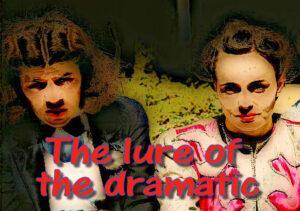
We are drawn… pulled… in directions we say we do not want to walk, and yet, there we are. We blame externals — other people, situations, etc. But take a look.
You ever notice how the people and things you wind yourself up over seem to have little or no effect on others?
Or conversely, the things others wind themselves up over seem silly to you.
If you are wise, you immediately realize that externals are not causal. In other words, all “situations” have multiple interpretations.
Thus, each situation has one result per “inter-actor.”As we experience situations, we are pulled to run toward, or run away. This is hard-wired into our selves. We have a propensity toward one or the other.
Secondarily, our actions and beliefs create chemicals (the things you feel in your body are triggered by chemicals hitting pleasure / pain sensors.) Because of the triggered feeling, we are pulled toward what turns us on.
We see this chemical response in action during dramatic events. Most people move away or freeze, and some run toward the incident.But the most interesting reaction is that of the professionals — soldiers, firefighters, cops, etc. If you watch, this happens: they react by flinching and perhaps moving one step away. And then you see the magic.
They stop, they breathe, and they turn toward, and move into danger.Mind, overcoming chemistry.Back to drama.
Drama is always a way to create “specialness.” Chemically, I become addicted to my self-importance. I puff out my chest, and demand that others “look at me.”
Here’s the odd part: it doesn’t matter what others do!Drama making is not about changing others or the situation. It’s about creating internal charge. The more addicted you are, the more you do it. Just like an addict.
This is why, looking at it from the outside, drama people seem to be working so hard to make their case. They are typically dealing with issues others take in their stride, and developing patterns that go on for decades.
Drama people will tell you they are working on doing things differently, but mostly follow that with excuses for why, this time, they need another dose. Just like druggies.
And it is the same for any repeated behaviour that you recognize is harmful. Just like NA is the same as AA, except for the thing that is the addiction.
A word about pain addictionsMy friend is starting to make the connection: she’s aware of the rush she feels when something goes wrong. Mostly, her relationships. For her, there is something big and dramatic about being dumped, or for staying in a dysfunctional relationship for months beyond its “best before” date.
You might be wondering why someone would set up their life this way. It’s because of the charge. The rush. the feeling of…
Pain, beautiful painMy mom had a burning passion to be the sickest person in the room. She learned this by being sick with rheumatic fever, and getting tons of attention. Until she died, she spoke of her illnesses in superlatives, and always with a slight smile.
Example: Decades ago Darbella discovered that one of her neck vertebrae was mis-formed. She needed neck fusion. My mom commiserated. “I know exactly how you feel. I broke my ankle once, and it was terrible!”
MY friend and I described her pain, her “feeling hard-done-by,” and her staying in bad relationships, as “Sort of like a pain orgasm.”
My point here, which I’ll expand on next time, is that our conditioning takes what we have experienced, and hard wires it in. It’s why habits are hard to break. And it’s not just wiring. It’s the pleasure chemicals that get triggered… it feels good to be bad.
We encourage self-exploration and self-expression, plus a change of behaviour.In Bodywork, we look for sounds to come out. For anger and sadness to come out. To be safely enacted.
The result?
I think each of us needs to explore what we are setting up to get our needs met, and to figure out ways to deal with what we need, without creating drama, using manipulation.“It feels so good to just let go! To feel, to express, to ask for what my body needs, and to know this is a much more healthy alternative to playing drama games.”
We could just cut to the chase and ask for what we actually want.
Look again at the top photo, of the adult and kid. Both are sitting comfortably. The kid’s spine is straight. The woman is twisted and non-level. I see that a lot. It’s about blocked passion. Most people are “twisted.”
Next time, I’ll talk a bit more about pleasure and pain.
Facebook TwitterNovember 10, 2024
My Husband and My Pelvis
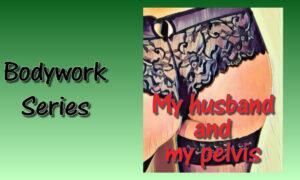
My Husband and My Pelvis — you are not a role, a relationship, or a thought. You are the totality of you — and especially what you experience
Back in the days of my website, I had a long section on Bodywork. As Bodywork was a big part of the work I did with clients, I wanted to provide information for home study. Anyway, I’m going to do a series of articles about Bodywork.
And you can learn more here:

PDF downloadable book and online videos. More info here.
It’s a difficult thing — learning to observe yourself as you play games. And one of the hardest games to catch, until you notice, is the myth of objectification.
Today’s title comes from a friend.The short version is that I’ve known her for decades. She attended our Workshops, did a little therapy, and a lot of Bodywork.
Like many Westerners, she lives in her head, and holds a lot of stories / judgements to be “true.” She’s into rules and roles, and self-protection. The latter led to not a few lower back issues.
One friend described her as “brittle.”She moves like someone walking on thin ice, and I guess that’s what her life appears to be like. One wrong step and “pow” — out goes her back.
The quote happened some years ago, at a time when she was seeing me plus two other body workers.We’d just finished a Bodywork session, and I made a pelvic reference, which was sort of a schema: “Your pelvis is tight, which has led to back issues, which are now spreading up your spine. But the root cause is a tight pelvis.”
So, from a Bodywork perspective, here’s the pelvic stuff.A tight pelvis is a blocked pelvis. To do the blocking, you have to “freeze” the pelvis (keep it from moving) — and you do that by tightening the muscles above the pelvis (at the mid back,) the stomach muscles and the leg muscles.
I had long ago decided that she as out of touch with her passion, and that she was fixated on “doing her life right.” As in, being a “good” daughter, “good” wife, “good” friend, etc.Her instinct is to be herself, and “herself” (like all of us) is messy, boisterous, passionate. But… her parents especially wanted her to control herself. To behave (in ways that would benefit them.)
Typically, when our body (which wants to move freely) and our minds conflict, the mind wins. It does so at the subconscious level. The un-dealt-with conflict becomes rigidified in the body. The mind brings the body under control by locking down. Suppressing.
Except it doesn’t work. Tightness leads to increased tightness, all the time. And that leads to more guardedness. All of this happens so the mind doesn’t have to “step up” and deal with the conflict between who we are ad who others demand that we be.
In talk therapy, I’d make the point that our stories are just that, and that they mean nothing. Humans are processes, not fixed entities. We are who we are, moment by moment, We are not labels.
With my friend, I’d suggest that she stop trying to please others (specifically, stop trying to “be good”) and to spend more time working on herself by finding and feeling her passion.
Which is a pelvic / lower back thing.
The back pelvis is the home to passion for life — it’s energetically where we feel our sense of purpose. The front pelvis is all about “passion for passion’s sake.” It’s about sensuality, sexuality and excitement.
Which is why dramatic pelvic motion catches our eye. Hulas, Latin dancing, pelvis rocking — all are related to “being turned on.” And for many people, such public displays are frowned upon.
In Breathwork, once you get the rhythm going we add in a pelvic tilt. We do so to free the energy trapped in the region, so that you can actually feel it. My friend has done some Breathwork in our Workshops, and I made a mental note to add it to her next Bodywork session.
Here (finally!) comes the quote!So, we were talking, and I said the above stuff about her pelvis, and she sighs and says,
“All three of you (her trio of body workers) say the same thing — I need to work on my pelvis.”
Me: “Great minds…”
She: “Of course, the three of you don’t think of my pelvis the way my husband does.”
I was speechless. No clue what to do with that. Other than to identify it as a world-class diversion.
For starters,she has no idea how I view her pelvis. Nor does she have a clue about the other 2 body workers.“my husband” is a role, not a person.and I think this is the important one, I was talking about how she relates to her pelvis! Suddenly, we’re talking about 3 body workers and her husband!Given the state of her pelvis, her husband was irrelevantThe issue for her is addressing her passion and sexuality and freedom and energy without reference to someone or something else. And she needed to address how her desire to be “good” gained her nothing but rigidity, stiffness and injuries.
Interestingly, she then said, “I need to do this more.” She put one hand on the small of her back and her other hand on her lower belly, and rocked her pelvis. Just like the pelvis rock in Breathwork.
OK, so here’s the upshot.A couple of weeks later, we were doing another Bodywork session. I set her up for Breathwork, and asked her to her to breathe, then add in the pelvic tilt.
Soon, her body started to vibrate a bit. She stayed with it for 10 minutes or so. Afterword, she said, “My whole body is tingling.”
I suggested that she keep doing Breathwork at home, and see what happens.
The tingle lasted for 3 days.This is the movement of energy (Chi, Qi, Prana) in the body, and it happens by getting out of your head and out of your own way. It’s life energy, and it’s there all the time. That we don’t notice it — that it “goes background,” doesn’t mean it’s not there.
At the end of the day, the issue is NOT how we understand stuff. Understanding is OK as a parlor trick, but shifting away from rigid definitions (and rigid bodies) means the freedom to experience.
My friend is a classic case of trying to understand, as opposed to letting herself live - feel, process, experience. This moment-by-moment alternative is not a replacement for thinking. It’s an alternative to “ONLY thinking.”
You might want to consider giving your mind a little pat on the head, and decide to breathe into your body. See if you can feel your passion, locate your drive, or simply enjoy the charge of being alive.
Stop trying to figure yourself outLet go of thinking, for a bit, by letting your thoughts flow. Let go of defining, blaming, getting caught in your head. Be appreciative ofr your thought processes, and recognize you have thoughts — you are not your thoughts.
Let yourself flow, let yourself be free, and drop the labels. No one’s son / daughter. No one’s husband / wife. Just play with being.

PDF downloadable book and online videos. More info here.
Facebook TwitterNovember 3, 2024
Passionate Engaging — Set Yourself Free Series
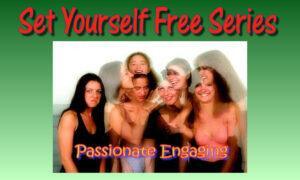
Passionate Engaging — Learning to engage whole-heartedly requires a surrender into passion and relating.

The. Best. Relationship. Ever.
I went in for a chiropractic session recently — I’ve been getting adjustments since I was a baby, and my back likes to get worked in every 3 weeks.
As I was lying there, my mind went on a side trip to all of the chiropractors I’ve been to. Back in 2012, when we were in Costa Rica, I hade quite the time finding one — until I didn’t.
We were in a grocery store, and Dar mentioned my dilemma to the owner of our condo.It turned out that
a) there was a chiropractor in town, and b) just as she mentioned him, he walked up and said “hi.”Odd world, eh? Anyway, the adjustment was great.
We were talking the whole time, about living in Costa Rica and generally getting to know each other. There was an interesting moment: given I’ve received adjustments forever, I’m pretty easy to work on.
He had one of my legs in the air, and was slamming into my inner thigh (to pop my SI joint) and it was taking a lot of effort. Finally, I had a big breath, and it popped.
He said, “Hard to let go and let someone new in, right?”This fits right in to what we’ve been on about for this series: finding the ways and means to stop holding on to what isn’t working, while shifting the only thing we can… our behaviour… to something that gets positive results.

As I think back, I’m remembering what the clients I worked with were able to accomplish, once they gave themselves permission to slide out of their need to plan, to order and understand.
Stunning insights, waves of feeling, all happening within the framework of “making contact” — with me, and more importantly, with themselves.
In the end, it’s never about the context - it’s always about the contact.
It’s oh so easy to look outside of ourselves for what’s going on, to default to old behaviours, to abrogate responsibility for where we are and what we are choosing. I don’t buy it.
In every moment, during every experience, I am choosing what I am doing. I therefore choose to be who I am. I am adult enough to own — to claim — responsibility for every second of my life.
What I’ve noticed is this: we need passion to transform ourselves — and the vehicle, or the laboratory for that transformation is found in our relating. Transformation rests in the action of relating, not in the fact of the relationship, per se.
In the relating, the self is transformed.
Transforming, and relating, are actions, not concepts.People say, “My relationship is in trouble.” I always respond by asking them to show me their relationship. They look puzzled. I tell them, “There is no relationship… there are your actions, and your partner’s actions, and those actions either get you the results you want, or don’t.” Talking about “the relationship” is a waste of time. Talking about what you are doing… that’s the key.”
Relating like this takes passionate engaging — reaching out, digging deep, being willing to be open and vulnerable. This can be scary or freeing.Passionate engaging is both deep and profound. This sort of relating is the direct opposite of the safety of mere communication — it requires endlessly moving away from head trips, explanations, and musings about “why” and “what’s right,” to the sharing of the heights and depths of ourselves — the revealing of our pain, our secrets, even our outright strangeness.
In my own patterns of relating, one problematic pattern is wanting to fix things. For example, when Darbella is hurting, I have a burning desire to jump in and make it all better.
This leaping in, at its root, is not about Dar — it’s about me trying to “fix” my discomfort with her pain. To simply sit with her as she explores her pain, or even more difficult, to sit with her as she simply chooses to be in her pain, seems, to that part of me that wants to “fix,” to be impossible.
Until I take a breath.In that moment of inner focus, I can see my fear of change, fear of pain, emerging. In my fear I choose to forget myself and to turn my attention outward, trying to move the universe so I can be happy.
In this process, which I loudly declare is all about Darbella, I am actually discounting her and her issues.
If I see this, I can begin to choose differently. With effort, I can choose to turn my focus back where it belongs. To me and to my curiosity.
I can choose to be curious about her and her experiences, while being responsible solely for my own.Often, people end relationships over their fear of intimacy, while the parties involved loudly proclaim that intimacy is what they are seeking. True intimacy, however, is about the opening up of the self for examination and sharing, and the ownership of my process. I must reveal all of it, and especially the parts I wish to hide, or wish I could get rid of.
To quote Ben Wong and Jock McKeen, in The NEW Manual for Life,
In our view, change of the basic personality is not possible. Often, seeking for change is a way of anesthetizing the anxiety of nonbeing that accompanies life. To accept one’s deep structures and tendencies often involves embracing this anxiety. To devote oneself to knowing one’s basic patterns (and accepting the accompanying anxiety) rather than trying to eradicate them, will allow for more self-acceptance, more self-responsibility, a greater inner strength and heightened self esteem… The more thoroughly people know their patterns and tendencies, the more varied, creative and spontaneous they can be. (p. 245)
This knowing of the self, and accepting of the self, presupposes letting others in on what’s going on. Often, we want to hide the dark stuff we consider to be too black for public consumption. Yet it is only in dialog — in the sharing of self — all of the self — that choice becomes available.
It is only after I admit to my games and foibles that I create the intent of doing things in a different way.
Relating, really relating, is difficult. It requires time, focus and commitment to self-revelation. Mostly, when the going gets rough, it requires nothing more than staying present and continuing to speak with curiosity.
Plus a deep willingness to share who you are in that moment of conflict.Life was never meant to be easy. We are complex creatures, driven by motives and passions that are as old as humanity itself — that link us to generations that came before us.
We bring ourselves, all of us, into our relating. The height of silly would then be to pretend we can hide the parts we judge to be unacceptable. The depth of wisdom is to reveal all, and be witnessed fully, with no cop outs, no pleas of “I don’t know what I’m doing” no excuses, and no running away.
In the end, I choose to relate fully, and to refuse to walk away when the sledding is bumpy. I get it “wrong” as often as I get it “right,” but the challenge, the passion and the joy of seeing myself more deeply, as well as through another’s eyes, makes it all worthwhile.
Facebook TwitterOctober 27, 2024
Dropping Manipulative Games — Set Yourself Free Series
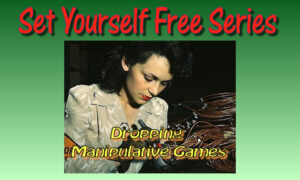
Dropping Manipulative Games — We manipulate because we want others to fix life for us. Learning to drop manipulation is the first step toward self-responsibility
For more on this topic, read:

My first and most popular book,
This Endless Moment.
Learn to live a full and satisfying life.
A client once said,
One of the very first lessons we need to learn is this: None of us have any power to make someone else do something (We’re not talking about pulling out a gun and forcing them–we’re talking about manipulative speech.)“My boyfriend insists on manipulating me — he demands that I do things his way. What can I do to change him, and if I can’t, do I dump him? And what if he dumps me first?”
What we typically describe as “manipulation by another” is always about our belief that we can be manipulated, followed by our choice to give up our personal strength.
This is an issue that affects each of us at some level. It’s an old issue, and it affects all of us because all parenting is nothing more than blatant manipulation, designed to “humanize” or civilize kids.That’s the prelude. Now, let’s dig in.Let’s start with a definition of manipulation.1. to treat or operate with the hands or by mechanical means especially in a skillful manner2a.to manage or utilize skillfully2b : to control or play upon by artful, unfair, or insidious means especially to one’s own advantage3. to change by artful or unfair means so as to serve one’s purpose(from Merriam-Webster OnLine )
Let’s whiz through these definitions.Definition #1: We use “manipulate” in a positive sense when we’re talking about activating and controlling, for example, machinery.#2a. We also use the word to describe the techniques, say, of a chiropractor or Bodyworker.#2b, #3: We use the term negatively when describing “unfair or insidious means.”And just to put it out there, “artful means” happens in, say, therapy (or this article!) and the Zen term for this is “Upaya.” (skillful means.) This is “good” manipulation, Like parenting is “good.” It’s designed to provide a safe environment in which one can make choices.Negative manipulation, on the other hand, is always about getting someone else to do what you refuse to fix in yourself.Let’s zip back to kids, and then leap forward to us.Let’s also get a couple of things straight.
When kids are born, they are, for all intents and purposes, autistic. Left to their own devices, they die. Period. Even though they have predispositions, genetic or otherwise, to a certain way of being, children are incapable of self-socialization (we call this “going feral.”)
Put a couple of 1 or 2 year olds in the same room and walk away, and sooner or later someone is going to be pounding the other over the head.
Socialization is learned behaviour, and parents set this in motion. It becomes the sole responsibility of the child at, say 16. This does not change the fact that socialization happens within a “manipulative” (hopefully skillful or artful, but often not) framework.
“Adults” provide the boundaries, the direction and the rules.There is no one human way of being, beyond the obvious biological behaviours of eating, drinking, eliminating, breathing, screwing, etc. That’s what makes travelling around the world so much fun, so much of a challenge.
People are as they are because that’s how they were brought up. That’s how they were molded, or manipulated into being. Without manipulation, society — civilization — would screech to a halt.
We can’t change how we were brought up. We do, however, have myriad choices about what to do when the “official manipulation” ends.
In the West, ever since the accursed advent of the New Age Movement, we’ve been on a slippery slope. Since the 60s there’s been reluctance to actually parent a child.
We hear all this, “They have to figure it out for themselves” stuff. Oer, “I don’t want to stifle their genius!” Gag me with a spoon.
It’s almost as if parents refuse to parent because they don’t want to insist on certain behavioural standards. Yet, when you think about it, basic behavioural standards, repeated consistently, are the foundations upon which the future is built.
And nothing is more important than instilling the foundation of “self-responsibility.” We manipulate them out of feral-ness, and into civility, and then (I fervently wish) teach them to stand on their own two feet, learn about themselves, and become self-responsible.
This as opposed to the new norm, which appears to be parenting (guiding, directing — whatever) until the “kids” are 60 or so…
I’m actually plugging the value of parental manipulation. But I’m using definition 2a, “to manage or utilize skillfully.”Here’s a story from some years ago: A friend was discussing a moment with her 8‑year-old son. Forever, she’d focussed on teaching him boundaries, choice and limits, age appropriately. He was in 2nd grade and, for the first time, had homework.
The “limit” is, homework has to be done by bath-time, which is a fixed, non-variable time. The choice is, does he do it when he gets home, right after supper, or at the end of his day? He’s been experimenting with several options.
So, one day, he decides to go for “evening.” Out he goes to play. Mom calls him in at homework time. This would be her job: he’s 8, and mom is providing the structure for his experience. (If she hadn’t he’d have stayed out, playing. We all know that.
The stated goal is, “homework done by bath time.” That stated goal is the structure.In he comes, upset, as his friends have just begun a game. During the next several minutes, mom reminded son of his choice. Son had his feelings. He cried, and with mom’s help, expressed his anger.
He vented that it was all mom’s fault because she called him in. Mom encouraged him to get it out his system.
There’s more to the story, but the nifty ending is this: amid tears, son says, “I really made a bad choice!” (This is the beginning of self-responsibility.)
This is teaching (i.e.positive manipulation) at its best. Her 8‑year-old owned his choice, his behaviour and his actions. Repeated again and again, he will eventually get to self-responsible.OK. So, structure and goals and boundaries are necessary for parenting. Where manipulation gets its bad name is when it’s used adult to adult, in an interpersonal relationship.
Let’s look at the question that provoked today’s article.“My boyfriend insists on manipulating me — he demands that I do things his way.”People manipulate because it works.
If I have a need or a want, and I discover that whining, griping, berating, begging or insisting causes my partner to cave in and give me what I want, why wouldn’t I do it? However, and it’s a big however, this only works if my partner chooses to give in to the manipulation.

Short of physical violence, (which is never, ever, appropriate) there is no way anyone can make me do anything. Further, there is no way anyone can make me feel anything.
We’ve been here endlessly, and we’re here again. No one makes me angry. I make me angry. I choose anger.
Hey, the 8‑year-old in the story, above, got this one. Wake up and get it!
So, the way to stop being manipulated is to stop caving in.Oh, sure. Here come the, “If he really loved me he’d stop doing that because I asked him to” swill. Phooey.
On some other planet maybe what you want would matter more than what your partner wants, (to him,) but not on this planet. On this planet, you get to be responsible for yourself, while engaging with your partner as if he is solely responsible for himself.
The “if he loved me, he’d…” statement is also a blatant attempt at manipulation.He wants you to change your behaviour from “x” to “y”. You want him to change from manipulating to not manipulating. What’s the difference?
Let’s all repeat this in chorus: “No one can manipulate me into doing anything. If I give in, I made a choice.”I once had a client who was having problems with her partner. She said, “I made a list of all the things he does that drive me crazy. I said, “If you love me (gag, gack) you won’t do any of these things ever again.”
She was actually pleased with herself!!!
I said, “Good! Clever! You made it ever so much simpler for him. Now he knows a whole pile of ways to push your buttons.”
She: “Oh! He wouldn’t do that!”
Me: “Has he in the past?”
She: “Yes”…Oh!”… my… god!”
Now, hopefully you know what I said next, and I hope you don’t think I said, “Well, maybe some day he’ll stop torturing you.”
What I said was, “You gotta get over yourself. Disconnect the buttons. Stop torturing yourself. If you wait for him to change so you can be happy, this is going to take forever.”
Second part of the question:“What can I do to change him, and if I can’t, do I dump him? And what if he dumps me first?”Answer: you can’t change another person. Only they can change themselves. Your choice is to absolutely and completely stop reacting to the manipulation. Period. It’s your life. Who’s responsible for it? YOU!
Now, if after stopping your reaction, and letting your partner know that this is your new way of being and choosing, your partner continues to attempt to manipulate, your choice is to either:
accept the fact that s(he) refuses to let go of that behaviour, and choose to stay, orleave.In other words,the first step is to stop acting like and seeing myself as a helpless victim of another’s manipulation.The second step is to make better choices by not giving in, ever, to manipulation.The third step is to observe what happens in the relationship when I stop biting. In the vast majority of cases, the manipulating stops, and dialog starts. And we reach an understanding. In some cases, not biting makes no difference, and the relationship becomes attempts at manipulation with no response. Some people choose to stay in this dynamic. Most leave.Take a look at what kinds of manipulation games you play. Are you the victim, the perpetrator, or both?
Cut it out. Grow up and let go. And just for the hell of it, give self-responsibility a go.
Facebook TwitterOctober 20, 2024
Unbinding — Set Yourself Free Series
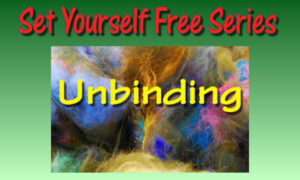
Unbinding — One can see the results of how one lives by looking directly toward the body. In other words, the body tells us what we need to know.

Looking for more on this topic?
Check out my book,
Half Asleep in the Buddha Hall.
Wayne’s “Eastern” book takes you by the hand and helps you to find peace of mind. Half Asleep in the Buddha Hall is a Zen-based guide to living life fully and deeply.
I just re-found an article I’d saved — it was in the Winter 2009 Buddhadharma magazine. The article is “Gautama vs the Buddha,” by Glenn Wallis.
If you’d like a one word description, here it is:
Unbinding.Here’s the article summary:If you’re looking for relief from suffering, argues Buddhist scholar and author Glenn Wallis, you won’t find it in some mythical figure named the Buddha but in the teachings of Siddhartha Gautama–an ordinary person like us, who became one of the world’s most gifted spiritual teachers.
He then talks about the core of it all, and uses a sutta (in Pali, sutra in Sanskrit) to describe the process.
Key conceptsAll of that eradication , which is described as the destination, is also known as Nirvana.One can see the results of how one lives by looking directly toward the body.The body tells us what we need to know. If we are angry, sad, depressed, bored, confused, infatuated — then we are bound up in these things — in infatuation, delusion, or hostility.If we are present — at peace, aware, open, honest, vulnerable, true to ourselves — we are unbound , and in that moment (what else is there?) we touch “all that there is.”This ongoing process of seeing into and being with is what meditation is all about.Destination — from the Parayana Sutta —
I will teach the destination and the path leading to the destination. Listen to what I say.
What is the destination? The eradication of infatuation, the eradication of hostility, and the eradication of delusion is what is called the destination.
And what is the path leading to the destination? Present-moment awareness directed toward the body. This awareness is what is called the path leading to the destination.
In this way, I have taught to you the destination and the path leading to the destination. That which should be done out of compassion by a caring teacher who desires the welfare of his students, I have done for you.
There are secluded places. Meditate, do not be negligent! Don’t have regrets later! This is my instruction to you.
As we learn to see when seeing, hear when hearing, we begin to let go of our attachment — our “bound-ness” — to the causes of suffering — namely, infatuation, delusion, and hostility.
Infatuation is the same as attraction.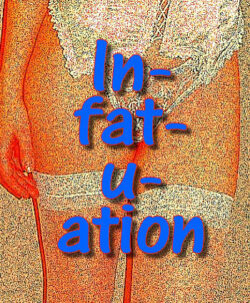
If I am drawn to something, if I must have something — or someone — then I have surrendered myself to (I am bound to) the thing I am attracted to.
I’m lucky, in that I’ve never been attracted to teachers or gurus. By this I mean that while I have known quite a few, I am not infatuated by them.
On the other hand, I sometimes infatuate myself with people whom I think are “getting it.” I tend to want to have them get what I get, and quite annoy myself when they persist in doing it their way.
For me, then, unbinding is endlessly letting go of my desire to make things happen.
My personal path is learning (endlessly) to let people go —away, astray, wherever they choose. If I romanticize them or their path, I pay the price of infatuating myself.
Hostility is the same as repulsion.I do not suffer fools gladly. I still have a highly judgemental streak. And I still set myself off over what I judge to be “dumb choices made by idiots.”
Guess which former president I’m thinking of right now…
Fortunately, I have somewhat learned to contain this tendency, and I “go off” less often. Although, I must admit, 2024 has been the focus of some dynamite rants.
Usually, I bend Darbella’s ear, while she laughs and shakes her head. Dar seldom gets her shorts in a bunch, and has difficulty (she tells me) understanding my obvious delight in winding myself up.
Rather than prolong this example, let me just present a photo of Dar, looking at me, mid-wind-up.

If I go to hostility, I again am putting myself out there, as opposed to in here. I am causing myself trauma, and blaming it on the behaviour of others—despite their behaviour being none of my business and out of my control.
Unbinding would be seeing the situation clearly, and choosing what I can do to bring myself back to peace.
Delusion is the same as being tuned out, unaware.
Delusion is thinking that the world owes me something.
Or that, because I’m a nice person, I deserve special treatment.
Or that it’s scary out there and I have to be cautious.
Or that my job is to fix everyone else, and then it will be my turn.
Or that how I feel and what is going on for me is up for either debate or approval from others.
And on and on.
Unbinding, paradoxically, has to do with “don’t know,” with seeing simply, without a lot of drama or explanation.
I mostly don’t delude myself, although I could be deluded about that…Present minded awareness directed toward the body is all about paying attention to the very real signs our bodies give us, signs that point to either distress or freedom.
I know how I am by being aware of what I am feeling, and observing what I am thinking.Once I get this, I can unbind myself from the games I am playing, the lies I am telling myself, and the dramas I am creating, and I can be in my body, where I am, moment by moment.
Unbinding is a way to remember.Much like untangling wool so that it is useful, unbinding ourselves from our confusions and distractions gives us the space and utility to be who we are.
Unbound. Real. Whole. Complete.
Facebook TwitterOctober 13, 2024
Learning by Letting Go — Set Yourself Free Series
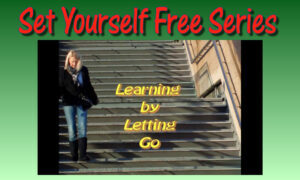
Learning by Letting Go — we need to work through our issues, and come to a place of understanding and elegance. Sometimes, when we reach that place, some letting go is required.
 Psst! Hey!
Psst! Hey!** Want more great writing designed to help YOU to shift your behaviour?
** Want to learn how to find, build or deepen your principal relationship?
** Want to know more about Zen living and being?
This week’s question:“So could I please ask you to talk about divorce, talk about healing and recovery from a broken dream, how it could be a chance of growth and development…”
I was checking out my bookcase, and rediscovered a series of books on Morita therapy — a style developed in Japan. The style embraces both Western approaches and Zen Buddhism. The book I picked up is one of several by David K. Reynolds, titled, Playing Ball on Running Water.
In Morita Therapy, clients are like Zen students; as students, they are provided with exercises and descriptions we might call “functional understandings.” It’s a truthful way of looking at therapy — the person is in therapy to gain a better understanding and a different approach to how life works.Anyway, I was browsing the book, reading sections I had highlighted, and came upon a section relevant to “manipulation.” There was a story about a woman was angry over her husband’s drinking and smoking — and had learned through Morita therapy that we cannot control other people.
Everything I write is about influence — it’s about me encouraging you to begin and continue a most interesting walk.– So, when she began to refuse to buy beer for her husband on her shopping trips, he said nothing, but she felt guilty about her efforts to influence his drinking.
Her misunderstanding was in confusing effort with results. There is nothing wrong with trying to influence others. We do it all the time. This book is my attempt to influence the way you think about certain things, and to influence what you do. Almost everything we say is an effort to influence others, at the very least to influence them to listen to us. Trying to affect other people is a natural, everyday aspect of human life. There is nothing inherently wrong with it, however concealing these efforts, using physical force, or using our influence to obtain certain goals may be wrong in many circumstances. On the other hand, to be attached to or to be obsessed with the effects of our actions to influence others is a mistake. Like any behavior, actions to change another person should be undertaken with full attention and wholeheartedly. But then we must leave it up to the person to decide whether to change or not.
I am indifferent to whether you understand and accept the life principles in this book. Some of you will find them intriguing and immediately beneficial. Others will reject them out of hand. That is your business. My success or failure lies not in whether I have convinced you of the wisdom of Morita’s method, but in the quality of my presentation. If I have written with full attention, as well as I can, then the outcome is of interest to me but not crucially important.
It is the same thing for the young housewife. She is quite appropriately concerned with her husband’s problem. Smoking and excessive drinking are very likely to shorten his life. She has every right to attempt to influence his habits. She has been quite clear with him about her purposes. But there her attachment must stop. Whether he stops drinking and smoking is his concern. She is personally interested in the outcome of her efforts, but she must not judge them in terms of the outcome. She does need to know if he stops in order to know whether she needs to continue trying to influence him to quit. But she must leave up to her husband, and him alone, the decision about how to respond to her behavior.
She cannot control him; she must not commit herself to controlling him. But, for her part, she is responsible for doing what she can to achieve her purpose. Again, her purpose is not to control him; her purpose is influencing, not the resultant effect.
David K Reynolds, Playing Ball on Running Water, Pgs. 30–32″
My responsibility stops with my writing. I influence through what I say and do, and you choose to respond or not.
As to marriage, relating and divorce, the un-learning is: we must not, as adults, spend our lives trying to “make” other adults understand, change, behave, love us, whatever.
I can’t stress this enough: You must not treat adults like kids.You have a right to your opinions, and you have a right to express your needs and wants (to influence.) You have no right to demand that others do your bidding. And vice versa.
Marriages fail because the participants cannot solve the “manipulation power struggle.” Both parties want the other to cave in, and neither party is willing to budge.
The fundamental differences become increasingly apparent, and are not seen as “interesting,” but threatening. This progression from fantasy to reality happens in every long-term relationship, as the partners move from falling in love (romance) to conflict.
Once we’re in “conflict,” we begin to see what Reynolds is describing, above: the confusion of effort with results.Let’s look at marital conflict. And, let’s agree on one other thing: no one on this planet, repeat, no one, was brought up like you. Not your siblings, not your neighbours, and definitely not your partner.
Despite this, I know you desperately want to believe that everyone sees the world just like you do. You assume when you spout some gem of “wisdom,” others are disagreeing or resisting out of spite:
You must believe that everyone thinks the same, because that’s what you keep saying, as you fight, “Everybody knows…”“No one else has to put up with…”“All the other wives (husbands)…”“Why can’t I wear a skirt that starts 3 inches below my navel, with a hem up to my crotch? All my friends are doing it!“
And dad replies, “Not in my house, son!”
And all of this “knowledge” you think you posses is based upon one thing: what you’ve learned to be comfortable with.
You were brought up by your parents and “tribes” with a ton of generalizations.While I seem to be hammering the same nail, what I’m trying to get across is this: there is no “one way” to see anything. I have my way of seeing and being, and you have yours. We can talk, and you can hear what I say and reflect upon it, and maybe even you’ll choose to agree with me.
Even if you do, however, how you understand and apply what I say will be absolutely unique to you.Now, if I go into a relationship not understanding any of this, what I’m going to do is to assume that my way of understanding how to “couple” is not only the “right” way, but the “only” way — the universal way.
Thus, “Everybody knows…”
Funny thing, though. My partner believes the same thing about his or her world view. “Everybody knows…” The conflict stage in relationship is two people, each of them thinking they are “right,” desperately trying to get their partner (the only person on the whole planet that’s out of step) to change.
Anger in relationships is directly attributable, every time, to both parties demanding change from their partner, and not getting it, while absolutely refusing to change anything about themselves..Once you reach the conflict stage, several forks in the road appear. in 95% of the cases, there are three options that arise:
staying and fighting,leaving and divorcing, orstaying but shifting one’s perspective to apathy.The 4th option, chosen by maybe 5% of couples, is to stop trying to be right and to simply accept your partner as he or she is. And then, with mutual agreement and humour, to, as Reynolds says, above, exert influence without attachment to the result.For many of of us, it may take more than one “marriage” to “get” this idea. Unreal expectations lead many of us to get married for all the wrong reasons. Those of you that have read my books and freebies will know that I have been married 3 times, briefly in University in the 60s — ah, the life of a hippie — and for 9 years in the 70s to early 80s.
Prior to marriage # 2,” I remember deciding to marry her because she looked good and I’d invested a year of time into the relationship.
This despite my having ended our dating relationship 3 times, each time thinking “We’re not even remotely compatible.”
I married her anyway, thinking, “There’s some stuff about her that I like, and the rest I can get her to change.”
When we reached the conflict stage, I took us to therapy, and she said, “There’s nothing I would change.” I was angry, she was apathetic. There, we stalled.
Finally, I decided that “stuck” wasn’t cutting it for me. Settling for an apathetic relationship lost its appeal. I made the decision that staying stuck for 50 years and then dying was not exactly the most interesting way to live my life. So, I ended it.
I was in therapist training when all of this happened, and I decided that I wanted for myself the kind of relationship that I was encouraging (and teaching) my clients to have — one of mutual respect, curiosity, non-manipulation (but lots of influencing!) and intimate dialogue.
I decided to find someone who wanted to commit to self-exploration as she related with me (tall order, I know…) and.. I found Darbella!Darbella and I have known each other since Sept. of 1982 — (Zowie, 42 years this past September!!! An amazing and fun ride, one I’m grateful for each day…) and this is her first marriage. Hmm. Maybe she should be writing this article…
We agreed early on (date one, actually) that we would follow the 4th option, and work through our issues by learning about, accepting, and understanding ourselves, as opposed to trying (and failing) to change each other.
So, in answer to the question of the week, divorce, in and of itself, teaches us nothing other than how to exit a bad relationship. Just take a step, and then another…
Just take a step, and then another…The learning comes afterwards, and perhaps also in the process of leaving.
The lesson I learned was that attempting to change another person into the person I wanted to be with is the height of arrogance.
To choose a partner who already is who I want to be in relationship with (who, as I see it, is walking a similar path) is wisdom.
And as I wrote above, the key to escaping conflict is to work through the power struggles and conflict together, noticing when either of us is trying to force the other to change.
We notice, we talk about it, and we accept, ever again, responsibility for ourselves and ourselves alone.
I learned that I could find a partner who would accept me as I am, for what I am, and in that relationship I found the courage and the strength to simply be that person.
When I jam myself up (and, of course, I still do, occasionally ) Darbella just laughs and waits until I get over myself. And I provide the same non-judgmental support for her.
We influence, without attachment to the result. For me, I have learned patience and I have faith in grace.And you know what? I wake up each morning and go to bed each night thankful, both for the chance, day by day, to meet myself, coming and going, and especially, each day I am thankful for Darbella.
For me, she embodies the depth of the grace of the universe. That which is fervently sought is often found. That which is required appears when one is ready. We walk our solitary paths together.
For me, that’s enough.
Facebook TwitterOctober 6, 2024
True Liberation — Set Yourself Free Series
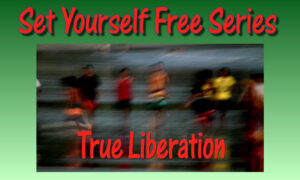
True Liberation — is an action. It’s liberating yourself from the need for explanations, figuring things out — a liberation into choosing to act for self and for the benefit of all.
 Psst! Hey!
Psst! Hey!** Want more great writing designed to help YOU to shift your behaviour?
** Want to learn how to find, build or deepen your principal relationship?
** Want to know more about Zen living and being?
A blog comment seemed to fit into the background preparation part, so here it is!
The Liberation of RelationshipsFirstly, I really enjoy and look forward to these “life pointers.”
Okay, secondly, I will not proclaim that I’m totally guilt free in regards to “over influencing” ppl, but mostly. And further, what’s on my mind is how a so-called victim may benefit by letting go as well.
For example, because of my Zen Buddhist leanings, I rarely if ever choose the route of pointless arguing or even being overly apathetic. Very few people in my life seem at all interested in meaningful dialogue, especially when they’re occupied in trying to manipulate me (which in truth, doesn’t really work and breeds resentment).
So, as divorce is a form of “letting go,” wouldn’t the same be said for moving on beyond fruitless, energy draining relationships? I mean honestly, in my life the goals I have don’t really mesh with my tribes at all. Further, matters didn’t really start out this way. I think the harder they insisted upon me following “their way” and the sanctions imposed for failure to comply, I was pushed even further away from their ideals and goal. I still endure regular manipulation and negativity from them. Am I in the wrong for finding my own way in the dark (so to speak)?
Also, I’ve been getting acquainted with Liberation Psychology and the idea of mental, physical, and spiritual liberation lately. It’s largely because I can see that they have some sort of hold on me although I mentally resist and try to negate much of their influence (which is like negative conditioning — how endearing).
I’m also wondering if there isn’t a karmic factor involved in my case because it’s nowhere totally comprehensible to me. I know I need to empower myself to the extent that I can move on, but am sensing a need for liberation in some meaningful form. I’d like to hear your thoughts on such liberation (Wayne) and if perhaps a karmic element might be impeding me or if it’s all just negative programming and low self-esteem.
Robert
As an almost universal rule, liberation does not happen in our families of origin. It’s the lucky person indeed that can have (or would want to have) meaningful discussions with one’s parents.

My mom and dad were two great people, and the best thing they ever did for me was to encourage me to hit the road from Buffalo NY to Elmhurst Illinois, for my BA.
At 17 years, 8 months.
The second greatest thing they did was letting me come home summers to make money at my dad’s store, and then send me back to Illinois.
I grew up, learned self-responsibility, and started getting over myself (still working on that one, eh Darbella???)My mom and dad moved to Canada in 1982, and lived nearby until they diedMy mom loved it when I was a Minister. She attended my church and she’d introduce herself thusly: “I’m the Minister’s mother.” When we got “exited,” mom and dad left with us. None of us ever went back.
Some years later, after a couple of strokes that altered her personality, mom said something to the effect of, “If I love me, you’d “find” another church. ”
My first response was, “Why, is one missing?”
Then, I shifted inside, and my internal reaction was,“How dare she ask me to do that? She was there! She knows how painful that was!”
Then, my internal, “Get over yourself” warning buzzer went off.I said, “When was the last time I did something just because you wanted me to?”
Mom: “When you were 17.” (I was 49 at the time…)
Me: “Noticing a pattern?”
Of course mom wanted me to do what she wanted me to do. She had wanted me to for my entire life. Her wish for control did not change after 22 years of not getting anywhere with me.She tried, I had an internal reaction, I got over myself, and said some form of “No.”
Attempts at manipulation by others is something that happens forever. So what?
The thing our writer is implying, above, is that manipulation automatically has to lead somewhere. “Endure regular manipulation and negativity…”What’s to endure?
This is the idea that others have some kind of mystical power over us. It’s the idea that others at least ought to back us; if not, they ought to leave us alone. We think that just because we told someone to leave us alone, they are (or should be) compelled to do so.
While I acknowledge having exactly that reaction to my mom’s question, the key for liberation comes next.
I didn’t want to do what she asked, so I didn’t, andI didn’t fight with her about it.She wanted what she wanted, and I did what I wanted. Emphasis on did.Another recurring topic above is “… finding my own way in the dark.”
That’s just it. It is not necessary to do this alone. There are several authentic systems of thought for getting over yourself; for and finding peace and presence. The one I write about in the main is Zen.
None of us are required to go at this alone. In fact, I warn against it, as all we do is re-affirm our prejudices and self-deceptions.
In Zen groups, one famous way to pass time is called a “Dharma Battle.” One person speaks, and the rest tear into the person’s understanding, probing for weak arguments.
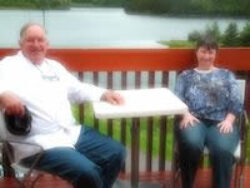
Years ago, our friend Rhoda reminded me of a dinner at our house, a decade earlier. A vice principal at school (the one Darbella and Rhoda taught at) had made acting like a dick into a science.
Rhoda was upsetting herself, and saying, loudly, “He makes me so angry!” Darbella and I replied, “You’re choosing to anger yourself. He’s not doing anything to you.”
Rhoda and I did “dharma battle” for more than an hour, with her totally denying my perspective.
Fade to ten years laterAlmost the first words out of Rhoda: “Remember that conversation in your back yard? That was the most profound lesson I’ve ever learned. I apply it all the time. Of, course, I figured out what you were saying after 30 minutes, but I liked the battle, too!”
The Liberation of SelfThis is really where it all begins. In Chakra language, this is the 3rd, solar plexus Chakra, and until one lets go here, nothing truly meaningful can happen in your life.Most people spend their lives “stuck,” and where they stick is on the themes of the first three Chakras:
Chakra 1- your right to be here, Chakra 2- your relationships, your sex life, and Chakra 3- your self-understanding.We go round and round, feeling impotent, feeling tight and constricted by our relationships, feeling sick about our selves.
Liberation Theology and PsychologyLiberation Psychology emerged out of Latin America’s Liberation Theology. The thrust was to suggest looking at socio-economic injustice as the cause of personal distress, as opposed to internal causes. Then, to do something about the injustice, through non-violent ACTION.
Zen says, “Look to the moment in front of you.” Same thing. The focus is on now-ness, not on why-ness.
Zen wants us to know how much trouble we make for ourselves, by endlessly messing around with “Why” questions — trying, and failing, to come up with why we are as we are.
“…they have some sort of hold on me although I mentally resist and try to negate much of their influence…”
Thoughts, beliefs, are vapour… not real„ so as such cannot get a hold on us. Quite the opposite. It is we who grasp on to them. Left alone (given their liberation, their freedom) they just drift over our mental landscape like clouds.
Imagine trying to “resist a cloud.” Or a wave.Or “trying” to negate something. My internal conversation re. my mom, above, was that. Trying to figure out the intention of another, without asking.
If I was interested in her thinking I could have asked, but truth be told, once I got over feeling hard-done-by, I wasn’t interested in her thinking or her suggestion.
So, once I saw that, there was nothing else to figure out, except an elegant reply.“… nowhere totally comprehensible to me…”Of course not. We can’t figure any of this stuff out, because all we do is tell ourselves stories.
Karma — “I’m also wondering if there isn’t a karmic factor involved in my case…”On karma, I have written elsewhere:
One of the main things to “get” is that we create every aspect of our own reality, and I mean every aspect. Another way to say this is to look at the concept of karma.
“In Buddhist teaching, the law of karma, says only this: “For every event that occurs, there will follow another event whose existence was caused by the first, and this second event will be pleasant or unpleasant depending upon whether its cause was skillful or unskillful.” A skillful event is one that is not accompanied by craving, resistance or delusions; an unskillful event is one that is accompanied by any one of those things. (Events are not skillful in themselves, but are so called only by virtue of the mental events that occur with them.)“
Now, the normal description of karma typically includes the idea of past lives, as in, “I must have done something really bad in my past life to deserve this.” I’d like you to put that aspect aside, as this is not even close to the actual intent of the word. It’s just a complication, and the last thing you need is some other distraction to keep you stuck. Karma is not a punishment. It’s simply an explanation of cause and effect.
Bad Karma is just an excuse for not acting skillfully
Must be… I wrote the book on it!

Looking for more on this topic?
Check out my book,
Half Asleep in the Buddha Hall.
Wayne’s “Eastern” book takes you by the hand and helps you to find peace of mind. Half Asleep in the Buddha Hall is a Zen-based guide to living life fully and deeply.
Mostly, people that concern themselves with karma (of the past lives variety) are trying to figure out how to justify staying stuck. Rather than move into the present experience, (which they just manifested by the choice before it occurred) and make a present-moment choice, they think they have no choice.
This is because doing things skillfully often means doing things differently.Initially, like learning anything, it’s slow, kludgy, and only a little skillful. With continual practice (and the feedback karma provides) the skill develops into mastery.
It’s essential to act. So, if my intention is not to bite on comments, but to breathe and respond in a measured way, then I need to drop all the excuses for not doing this. No more blaming genetics, history, or karma. I simply have a breath, or maybe even two, and respond in another way.
Because, you see, it’s simple.Act as you choose to act, accept the consequences for your actions, and use that to decide what to do next. Wash, rinse, repeat.
Liberation is not a perspective or a belief. It’s an action.In Latin America, it’s writing and publishing knowing you might get killed for it.It’s Gandhi, marching to the sea and picking up salt.It’s the Buddha, sitting still and teaching, facing down Mara, and his demons, with compassion.It’s “DO unto others…”Rumi: Rise up nimbly and go on your strange journeyto the ocean of meanings.
The stream knows it can’t stay on the mountain.
Leave and don’t look away from the sun as you go,
in whose light you’re sometimes crescent, sometimes full.It’s all action
I invite my friends to dance with me, and by that I mean, like sweet Rhoda, to engage fully.
It might mean arguing, or it might mean expressing emotions fully and deeply.
It might mean staying put when you want to run away, or doing what you say you’ll do despite the stories you tell yourself.
It might mean inviting more intimacy when you are scared to say or do or reveal.
It might mean doing your work, no matter what.
Or, you could continue to try to figure it all out.
No one has, but hey, good luck, eh?
Facebook Twitter


